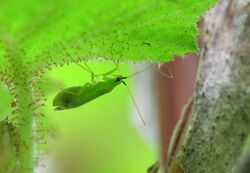Biology:Macrolophus pygmaeus
| Macrolophus pygmaeus | |
|---|---|

| |
| Scientific classification | |
| Domain: | Eukaryota |
| Kingdom: | Animalia |
| Phylum: | Arthropoda |
| Class: | Insecta |
| Order: | Hemiptera |
| Suborder: | Heteroptera |
| Family: | Miridae |
| Genus: | Macrolophus |
| Species: | M. pygmaeus
|
| Binomial name | |
| Macrolophus pygmaeus (Rambur, 1839)
| |
| Synonyms[1] | |
| |
Macrolophus pygmaeus is a species of plant bug in the family Miridae.[1][2][3][4] It is found in Europe except the high north, south to north Africa and east to Asia Minor then to Central Asia.[1] This species is omnivorous, preying on Tuta absoluta eggs and larvae,[5] Ephestia kuehniella eggs, Macrosiphum euphorbiae nymphs,[6] and plants such as Vicia fava. When feeding on plants, M. pygmaeus consumes extrafloral nectar.[7] Its varied diet has created interest in M. pygmaeus as a pest control insect for the prior mentioned species.
Seismic communication
Males use vibrational communication in their courtship process, actively walking down the host plant until a female is found. Macrolophus pygmaeus males produce a vibrational sound called a “yelp” that is associated with male-male interactions. The yelp is also associated with physical contact between the two males, and then the males running away while emitting yelps. The duration of the signal as well can affect the female’s response, and it was shown that females typically prefer longer calls.[8]
References
- ↑ 1.0 1.1 1.2 "Macrolophus pygmaeus Report". https://www.itis.gov/servlet/SingleRpt/SingleRpt?search_topic=TSN&search_value=718523. Retrieved 2018-05-03.
- ↑ "Macrolophus pygmaeus species details". http://www.catalogueoflife.org/col/details/species/id/18537283168ff767a52077208df22793. Retrieved 2018-05-03.
- ↑ "Macrolophus pygmaeus". https://www.gbif.org/species/2011308. Retrieved 2018-05-03.
- ↑ "Macrolophus pygmaeus Species Information". https://bugguide.net/node/view/1162876. Retrieved 2018-05-03.
- ↑ Chailleux, Anaïs; Wajnberg, Eric; Zhou, Yuxiang; Amiens-Desneux, Edwige; Desneux, Nicolas (December 2014). "New parasitoid-predator associations: female parasitoids do not avoid competition with generalist predators when sharing invasive prey". Die Naturwissenschaften 101 (12): 1075–1083. doi:10.1007/s00114-014-1246-3. ISSN 1432-1904. https://pubmed.ncbi.nlm.nih.gov/25331170/.
- ↑ Sylla, Serigne; Brévault, Thierry; Diarra, Karamoko; Bearez, Philippe; Desneux, Nicolas (21 November 2016). "Life-History Traits of Macrolophus pygmaeus with Different Prey Foods" (in en). PLOS ONE 11 (11): e0166610. doi:10.1371/journal.pone.0166610. ISSN 1932-6203. PMC 5117678. https://journals.plos.org/plosone/article?id=10.1371/journal.pone.0166610.
- ↑ Portillo, Nati; Alomar, Oscar; Wäckers, Felix (March 2012). "Nectarivory by the plant-tissue feeding predator Macrolophus pygmaeus Rambur (Heteroptera: Miridae): nutritional redundancy or nutritional benefit?". Journal of Insect Physiology 58 (3): 397–401. doi:10.1016/j.jinsphys.2011.12.013. ISSN 1879-1611. https://pubmed.ncbi.nlm.nih.gov/22245441/. Retrieved 25 August 2023.
- ↑ Gemeno, César; Baldo, Giordana; Nieri, Rachele; Valls, Joan; Alomar, Oscar; Mazzoni, Valerio (July 2015). "Substrate-Borne Vibrational Signals in Mating Communication of Macrolophus Bugs" (in en). Journal of Insect Behavior 28 (4): 482–498. doi:10.1007/s10905-015-9518-0. ISSN 0892-7553. http://link.springer.com/10.1007/s10905-015-9518-0.
Further reading
- "On-line Systematic Catalog of Plant Bugs". American Museum of Natural History. http://research.amnh.org/pbi/catalog/. Retrieved 2019-07-02.
External links
Wikidata ☰ Q10573776 entry
 |


